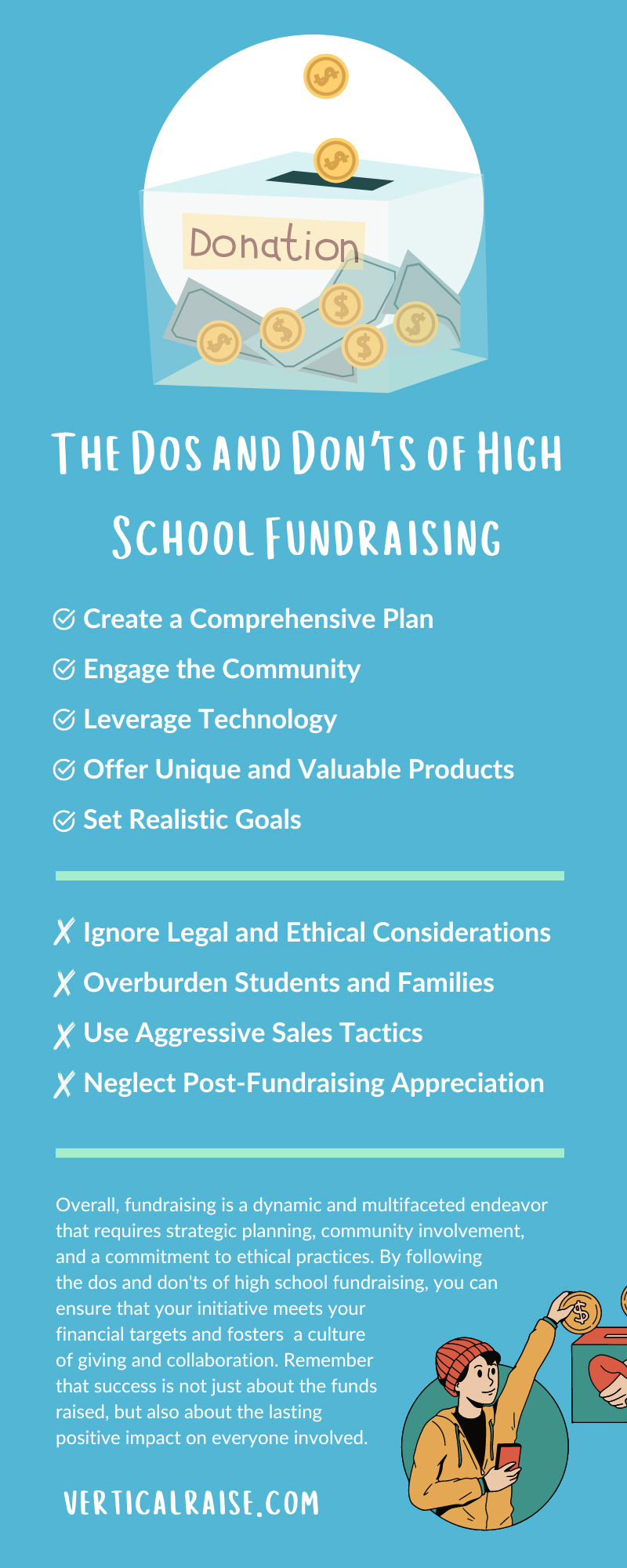
Published April 23, 2024
High school fundraising teaches invaluable life skills, instills a sense of community, and helps finance activities that enhance the educational experience. However, planning and executing a successful fundraiser involves meticulous organization, community engagement, and careful consideration of ethics.
In this comprehensive guide, we’ll unveil the dos and don’ts of high school fundraising. From creating a plan to showing appreciation to donors, these tips will ensure your fundraising initiatives are strategic, ethical, and rewarding for everyone involved.
Do: Create a Comprehensive Plan
Effective fundraising doesn’t happen by chance. Before you launch into the logistics of what you’re selling, you must craft a well-thought-out plan. This should include considering your fundraising goal, potential initiatives, timeline, assigned responsibilities, and budget. Diving into a fundraiser without a clear plan is like setting sail on a boat without a map. Make a plan to make your fundraising experience more efficient and effective.
Your plan should also address marketing strategies, volunteer recruitment, and contingency plans. For instance, if you’re selling products, decide on a price point that ensures profit without overpricing. Consider seasonal factors, like whether your chosen time period coincides with an oversaturation of similar campaigns, which could impact your success.
Do: Engage the Community
The success of high school fundraising often hinges on how well you can rally community support. Local businesses, alumni, and parents can become your most invested allies. Create a sponsorship program that allows businesses to donate and gain recognition within your school community. Encourage alumni to participate in fundraising events by leveraging social media and newsletters.
For parent engagement, offer volunteering opportunities that allow them to be involved in their child’s educational experience. Host kickoff events that bring everyone together and build excitement. When the community feels involved, they are more likely to contribute and support your cause.
Do: Leverage Technology
In today’s digitally driven world, using technology to streamline fundraising is essential. Utilize social media to spread the word, create online donation platforms that simplify giving, and consider online tools that track sales and inventory. Digital auctions or raffles can expand your reach beyond the local community.
Additionally, invest in a user-friendly website to showcase your fundraising efforts. This digital space can be a hub for donors and potential supporters to learn more about your cause and how they can help.
Do: Offer Unique and Valuable Products
To stand out in the saturated market of fundraising, you must offer products that are unique and valuable. Conduct market research or surveys to understand what your potential donors are interested in purchasing.
Choose quality products that align with your school’s reputation. Whether it’s a local artisanal product, a school-exclusive design, or an eco-friendly item, provide something that donors will feel good about buying.
Do: Set Realistic Goals
A common pitfall in high school fundraising is setting unattainable goals. While ambitious targets can be motivating, they must also be realistic. Your goal should consider the size of your school community, the marketability of your product or initiative, and the capacity of your team.
Take a data-driven approach to goal setting by analyzing past fundraisers and the benchmarks they achieved. This historical context can provide insights into what you can expect for the current campaign. Be transparent about your goals with your team and community and ensure they understand the rationale behind the targets.
Don’t: Ignore Legal and Ethical Considerations
With all the excitement that fundraising brings it can be easy to overlook legal and ethical considerations. Familiarize yourself with local fundraising regulations and ensure compliance with any necessary permits or licenses. Choose products and initiatives that do not harm the environment or exploit labor and engage in transparent communication with donors about the allocation of their contributions.
Don’t: Overburden Students and Families
The intent of high school fundraising is to enrich the educational experience, not burden students and families. Be mindful of the time and financial commitments you ask for as balancing academics, extracurriculars, and personal time is already challenging for high school students.
Consider low-impact fundraising methods, like passive fundraisers that don’t require students to sell items or commit significant time. Additionally, try to involve their supportive family members without placing undue pressure on their wallets or schedules.
Don’t: Use Aggressive Sales Tactics
Aggressive sales tactics are unethical and can give your fundraiser a bad reputation. Avoid pressuring potential donors or using guilt to prompt a sale. Instead, foster a spirit of giving by highlighting the benefit of donating to the school community.
Encourage your volunteers to use persuasive yet polite language and focus on the positive impact of the fundraising rather than meeting sales quotas. Reiterate the voluntary nature of donations and remind them to show appreciation for all contributions, regardless of size.
Don’t: Neglect Post-Fundraising Appreciation
Once the fundraiser is over, remember to show appreciation to the people who contributed. Send personalized thank-you notes to donors, recognize the efforts of your volunteers, and provide a summary of how the funds were utilized.
This step is critical for maintaining goodwill and encouraging future support. It also reinforces the sense of community and accomplishment among your volunteers and supporters. Neglecting this appreciation can make donors feel undervalued and less likely to support your future initiatives.
Tips for Measuring Success
By monitoring the results of your high school fundraiser, you can assess its effectiveness and improve future campaigns. Utilize key performance indicators (KPIs) such as the amount of funds raised, the number of donors, and the ROI on your fundraising expenses.
Surveys and feedback can provide qualitative data on donor satisfaction and areas for improvement. Additionally, take some time to reflect on the process with your volunteers and the wider school community to glean insights into what worked well and what needs improvement.
Overall, fundraising is a dynamic and multifaceted endeavor that requires strategic planning, community involvement, and a commitment to ethical practices. By following the dos and don’ts of high school fundraising, you can ensure that your initiative meets your financial targets and fosters a culture of giving and collaboration. Remember that success is not just about the funds raised, but also about the lasting positive impact on everyone involved.
At Vertical Raise, we help a variety of high school groups raise more money in less time. Our online donation platform can take your soccer fundraisers ideas, or any other group activity, to the next level. Contact us today to harness the power of online fundraising and learn how we can help you reach your goals.

